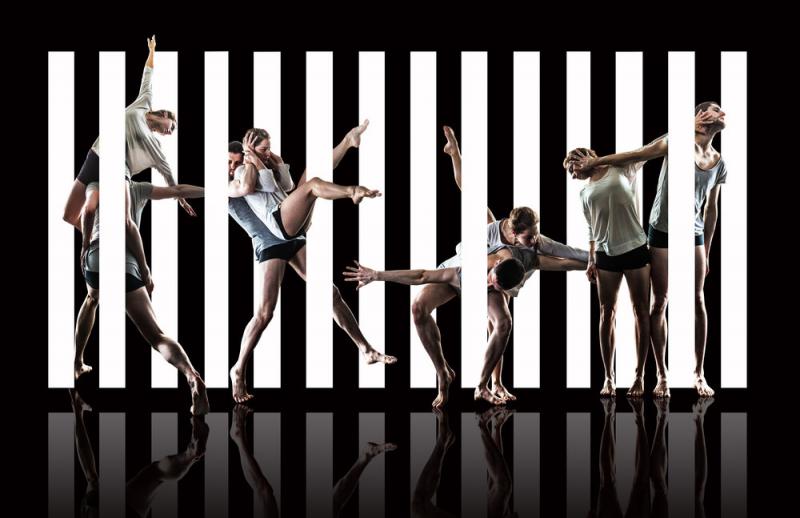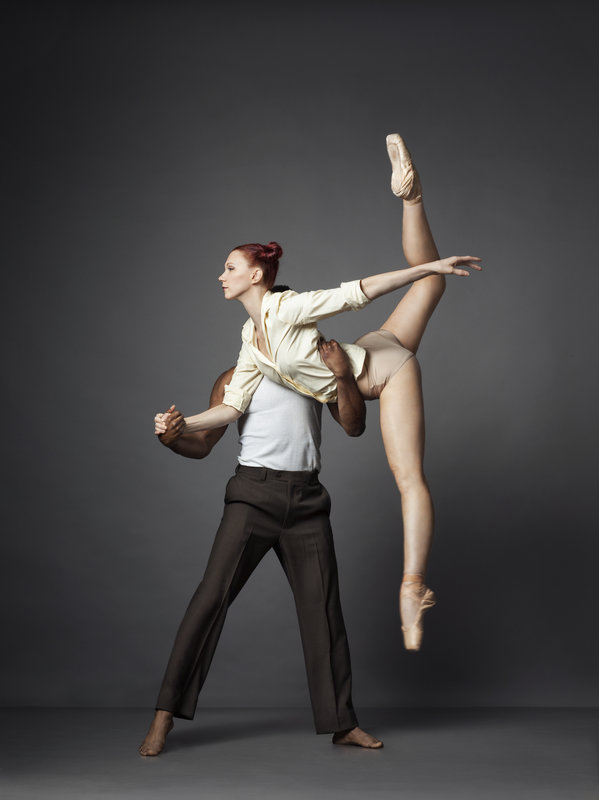Thomas Adès, See the Music, Hear the Dance, Sadler's Wells | reviews, news & interviews
Thomas Adès, See the Music, Hear the Dance, Sadler's Wells
Thomas Adès, See the Music, Hear the Dance, Sadler's Wells
Composer's works matched with contemporary choreography by McGregor, Armitage, Whitley and Pite

The challenge was already in the title for me: as both a dance critic and a strongly visual person, in the normal order of things I see the dance first and hear the music second.
What a remarkable pleasure it is to hear music of this calibre and complexity used for contemporary dance. Too often, new scores written for contemporary pieces are either bland sound-painting, or dreadfully dull, and so I was delighted and intrigued by the seriousness and richness of Adés's scores when I started listening to them before the show. An even greater pleasure awaited at Sadler's: the very fine playing of the Britten Sinfonia entirely unmarred by any trace of the Wells's customary, infuriating amplification.
Wayne McGregor's Outlier was made on New York City Ballet in 2010, which means it has a pronounced ballet aesthetic (the upward-striving line of feet on pointe, pirouette-like spins in partnering). For the contemporary dancers of McGregor's own company, Random Dance, recreating that City Ballet look must have taken a phenomenal amount of work, and they deserve credit for doing it really rather well (even if one could still tell that this was a piece made for a ballet company, and not being performed by one). Random's mostly-polished rendition of McGregor's trademark direction-changing, kinetic, hyper-flexible style was a good match for the phenomenal violin concerto Concentric Paths, which was played superbly by Thomas Gould. The concerto's long central movement provides the most strongly dance-like sections of music, including snatches of a tango and a waltz, and it's this movement which McGregor uses to construct a couple of compelling scenarios: a woman rebuffing a man with barely suppressed annoyance, and later two men in pas de deux. Music and dance one-all after the first round. In Life Story, it's very much the music we note first. The curtain rises on soprano Claire Booth in a black, shimmery floor-length gown (cue stifled sighs of admiration in the stalls), leaning on the an open grand piano with all the casual, sensual arrogance-tinged-with-world-weariness of a time-served bar singer. Back to the audience, her shoulder blades twitch languidly, laconically, as the piano's opening notes bubble up, low and liquidly percussive as percolating coffee. Booth keeps her singing of Tennessee Williams' fabulously black-comic words as low in her voice as possible, eschewing vibrato or the temptation to rest on the high notes, which she slides off with delicious disdain. With physical charisma like Booth's so near the front of the stage it was almost impossible to tear my eyes off her to the dancers, Emily Wagner and Ruka Hatua-Saar.
In Life Story, it's very much the music we note first. The curtain rises on soprano Claire Booth in a black, shimmery floor-length gown (cue stifled sighs of admiration in the stalls), leaning on the an open grand piano with all the casual, sensual arrogance-tinged-with-world-weariness of a time-served bar singer. Back to the audience, her shoulder blades twitch languidly, laconically, as the piano's opening notes bubble up, low and liquidly percussive as percolating coffee. Booth keeps her singing of Tennessee Williams' fabulously black-comic words as low in her voice as possible, eschewing vibrato or the temptation to rest on the high notes, which she slides off with delicious disdain. With physical charisma like Booth's so near the front of the stage it was almost impossible to tear my eyes off her to the dancers, Emily Wagner and Ruka Hatua-Saar.
Choreographer Karole Armitage, who made this piece in 1999, has given them an intricate, contemporary pas de deux, which echoes the detached, confrontational dynamic between the two characters in the song lyrics. The dance also echoes the dynamics of the music: Wagner lands from a jump and doesn't stop, melting down and down into a deeply arched backbend that recalls Booth's vocal swooping around the scale, while the spare elegance of Adès's piano playing is mirrored in lifts that make a feature of Wagner's long, clean legs (pictured right). But for sheer force of personality, the music scraped home with a victory in this round.
Alexander Whitley had the longest piece of the night – Adés's Piano Quintet – for his new commission, The Grit in the Oyster. Again, the musicians are on stage, and the three dancers must compete with them for visual attention. The piece's idiom centres on turning, with almost every lateral movement continuing into a spin or a roll. It gives a sense of constant, rapid movement, but with flow and rounded edges, not the discontinuities and corners that would alienate – as well, of course, as echoing the music's circling round. Occasionally the three dancers come to rest in tender, companionable embraces, matching in tone the peace that often seems to radiate from the piano, which sometimes sounds almost Finzi-ish, as if it's breathing a different, lighter air from the worried, restless strings. The dance builds to a mesmerising conclusion in the final third, as Antonette Dayrit dances alone and then tries to re-engage with the other two dancers (Jessica Andrenacci and Whitley himself), interfering in their pas de deux; this late surge helps to erase the memory of the slower sections in the middle, which is where my interest definitely wandered. Slight victory for the music again, I think
Crystal Pite, in choreographing Polaris (the night's other new commission), to Adès's cinematic canvas of sound, has chosen to "see" the music by matching it with an equally cinematic, visually transporting piece of dance. Sixty-four dancers are dressed all in black and move and pulse as one, to create a great, quivering, many-limbed creature that flows and unwinds, transforming its shape like an octopus squeezing through rocks. For me, the smudgy, yellowy grey of Jay Gower-Taylor's backcloth and Tom Visser's dim lighting suggested the cold, murky waters of the polar regions, and the dancers seemed to be moved around as if by waves and eddies, fragmenting and re-forming as if a shoal of fish, a cloud of squid-ink, or the crystalline slush of soft pack ice.
Pite has a rare talent for movement that makes people look at once more and less human, and when they occasionally detach themselves from the crowd, individual dancers seem both transcendent and alien. But the chief glories of the piece are its ambitious set-pieces for massed dancers: a chain of arms that ripples snakelike (shades of Akram Khan's Dust), or the sequential freezing of dancers in a low sprint across the stage, as if caught in a series of rapid-shutter camera exposures. It's all executed with great fluency and control by the dancers from Pite's company, Kidd Pivott, and students from London Contemporary Dance School and Central School of Ballet. Huge scope and spectacle definitely brought the dance out on top here, matching the theatricality of Adès's score (played from corners of the auditorium as well as from the pit, with the composer himself at the baton) with something just as impressive.
Alexander Whitley remarked the potential danger of choreographing to Adès: that the music would distract the audience too much from the dance. That did happen to a certain extent last night, but it was a pleasure to be distracted by something of such quality – and probably a deserved payback for all the times in dance performances that the music has been decidely secondary to the movement on stage. So fair dues all round last night – and extra applause for Sadler's Wells for putting on (and pulling off) such an ambitious event.
rating
Share this article
The future of Arts Journalism
You can stop theartsdesk.com closing!
We urgently need financing to survive. Our fundraising drive has thus far raised £49,000 but we need to reach £100,000 or we will be forced to close. Please contribute here: https://gofund.me/c3f6033d
And if you can forward this information to anyone who might assist, we’d be grateful.

Subscribe to theartsdesk.com
Thank you for continuing to read our work on theartsdesk.com. For unlimited access to every article in its entirety, including our archive of more than 15,000 pieces, we're asking for £5 per month or £40 per year. We feel it's a very good deal, and hope you do too.
To take a subscription now simply click here.
And if you're looking for that extra gift for a friend or family member, why not treat them to a theartsdesk.com gift subscription?

Add comment